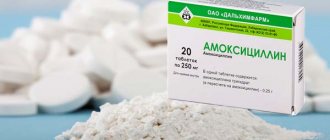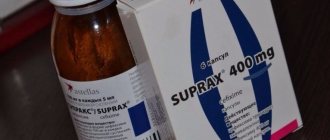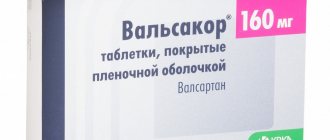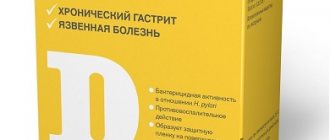Release form and composition
Dosage form: dispersible tablets: pale orange, oblong, scored on both sides, have a strawberry scent (1, 5 or 7 pcs in blisters; 1 or 2 blisters in a cardboard pack).
Composition of 1 tablet:
- active substance: cefixime – 400 mg (cefixime trihydrate – 447.7 mg);
- auxiliary components: calcium saccharinate trisesquihydrate – 20 mg; colloidal silicon dioxide – 5 mg; Magnesium stearate – 10 mg; microcrystalline cellulose – 44.5 mg; povidone – 5 mg; low-substituted hyprolose – 40 mg; strawberry flavor PV4284 – 2.5 mg; strawberry flavor FA15757 – 5 mg; sunset yellow dye (E110) – 0.3 mg.
Suprax's analogs
It is necessary to use analogues or substitutes for the drug Suprax only if this remedy is not suitable. In order not to aggravate the situation or worsen your overall health, it is better to consult with your doctor. The drugs may differ in composition and, as a result, pharmacological action and effect.
List of cheap analogues of Suprax
| Drug name | price, rub. | Manufacturer country |
| Tavanik | 480-920 | France |
| Klacid | 570-890 | Italy |
| Augmentin | 140-450 | Great Britain |
| Flemoklav | 320-450 | Netherlands |
| Cephalexin | 80-150 | Serbia |
| Furamag | 550-720 | Latvia |
| Vilprafen | 260-1300 | Germany |
| Monural | 440-1100 | Switzerland |
| Tsedex | 500-750 | |
| Flexid | 280-350 | Slovenia |
| Tsiprolet | 60-290 | India |
| Russian analogues | ||
| Amoxicillin | 58-507 | Russia |
| Flemoxin Solutab | 230-500 | |
| Ciprofloxacin | 50-120 | |
| Levofloxacin | 130-950 | |
Before purchasing and starting use, you should carefully read the existing restrictions, especially those related to age.
Pharmacological properties
Pharmacodynamics
Suprax Solutab is one of the semisynthetic antibiotics from the group of third generation cephalosporins for oral administration. It has a bactericidal effect, the mechanism of which is based on the inhibition of the synthesis of bacterial cell walls. Cefixime exhibits resistance to the action of broad-spectrum β-lactamases produced by various gram-negative and gram-positive bacteria.
The effectiveness of cefixime has been confirmed for infections associated with Proteus mirabilis, Escherichia coli, Neisseria gonorrhoeae, Streptococcus pneumoniae, Haemophilus influenzae, Streptococcus pyogenes, Moraxella catarrhalis.
Cefixime is also active against gram-positive and gram-negative bacteria, including Citrobacter diversus, Streptococcus agalactiae, Haemophilus parainfluenzae, Proteus vulgaris, Citrobacter amalonaticus, Shigella spp., Salmonella spp., Klebsiella pneumoniae, Pasteurella multocida, Klebsiella oxytoca, Providencia spp.
Listeria monocytogenes, Enterococcus spp., Pseudomonas spp., most strains of Enterobacter spp., Staphylococcus spp. are resistant to the drug. (including methicillin-resistant strains), Clostridium spp., Bacteroides fragilis.
Pharmacokinetics
Main characteristics of the active substance:
- absorption: bioavailability after oral administration is 40–50%, it does not depend on food intake. The maximum plasma concentration of the substance in the blood after taking 400 mg of the drug is achieved after 3–4 hours and varies in the range of 2.5–4.9 mcg/ml, after taking 200 mg – from 1.49 to 3.25 mcg/ml. Eating does not significantly affect the absorption of the drug from the gastrointestinal tract;
- distribution: with the introduction of 200 mg of cefixime, Vd is 6.7 l, when Css is reached - 16.8 l; approximately 65% is bound to plasma proteins. The highest concentrations of cefixime are recorded in bile and urine. The substance penetrates the placenta. Its concentration in the blood of the umbilical cord reaches 1/6–1/2 the concentration of Suprax Solutab in the maternal blood plasma; Cefixime is not detected in breast milk;
- metabolism and excretion: half-life is 3–4 hours, the substance is not metabolized in the liver; 50–55% of the dose taken is excreted unchanged in the urine within 24 hours, about 10% is excreted in the bile.
In case of renal failure, it is possible to increase the half-life and, accordingly, the plasma concentration of the drug and slow down its elimination by the kidneys. In patients with a creatinine clearance of 30 ml/min, when taking 400 mg of cefixime, the half-life increases to 7–8 hours, the plasma concentration of the substance averages 7.53 mcg/ml, and urinary excretion in 24 hours is 5.5%. In case of liver cirrhosis, the half-life increases to 6.4 hours, the time to reach the plasma concentration of the substance is 5.2 hours; at the same time, the proportion of Suprax Solutab eliminated by the kidneys increases.
Special recommendations
Before prescribing the drug, the doctor must carefully read the instructions for this medication; he pays attention to several recommendations regarding the use of the drug, these include:
- In patients with an allergic reaction to penicillins, including those suffered in the past, the use of the drug is not recommended, since cross-allergy to cefixime cannot be ruled out.
- Long-term use of tablets can lead to a decrease in the number of bacteria representing normal microflora in the intestines with the development of dysbiosis. In this case, after completing the course of antibiotic therapy, it is recommended to take medications from the pharmacological group probiotics or eubiotics to restore normal microflora.
- Dissolving tablets to obtain a suspension is possible only in clean water at room temperature.
- The use of this drug for pregnant women is possible only for strict medical reasons, if the expected benefit to the mother significantly outweighs the potential risks to the fetus.
- While taking Suprax Solutab tablets, it is possible to obtain a false-positive laboratory test result for glucose in the urine, as well as a Coombs test.
- The active component of the drug may interact with indirect anticoagulants, carbamazepim, calcium channel blockers, so if they are used, it is important to warn your doctor about this.
- Due to the possible development of negative side reactions while taking the drug, it is advisable to refrain from work that requires sufficient concentration of attention and speed of psychomotor reactions, or to perform it with extreme caution.
In the pharmacy chain, Suprax Solutab tablets are sold only with a doctor's prescription. Their independent use without appropriate prescriptions is excluded, as this can lead to complications.
Instructions for use of Suprax Solutab: method and dosage
Suprax Solutab is taken orally, regardless of food intake. The tablet can be swallowed whole with a sufficient amount of water or pre-diluted in water (you need to drink the suspension immediately after preparation).
The daily dose for adults and children weighing over 50 kg is 400 mg (can be divided into 2 parts), for those weighing 25–50 kg - 200 mg in 1 dose.
The duration of therapy is determined by the nature of the disease and the type of infection. Once symptoms of fever/infection have resolved, it is advisable to continue treatment for 48–72 hours.
Recommended duration of use of Suprax Solutab 400 mg tablets:
- ENT and respiratory tract infections: 7–14 days;
- tonsillopharyngitis caused by Streptococcus pyogenes: at least 10 days;
- uncomplicated gonorrhea: 1 day;
- uncomplicated infections of the lower and upper urinary tract in men: 7–14 days;
- uncomplicated lower/upper urinary tract infections in women: from 3 to 7–14 days.
In cases of impaired renal function, the dose is determined by creatinine clearance:
- 21–60 ml/min or patients on hemodialysis: reduction of the daily dose by 25% (it is recommended to use other dosage forms);
- ≤ 20 ml/min or patients on peritoneal dialysis: reduce the daily dose by 2 times.
Indications for use
The use of Suprax Solutab tablets is indicated for the etiotropic treatment of infectious diseases, the development of which is caused by bacteria sensitive to the drug:
- Inflammation of the tonsils (tonsillitis) and pharynx (pharyngitis), caused mainly by streptococci.
- Infectious and inflammatory process in the paranasal sinuses (sinusitis).
- Uncomplicated urinary tract infection, accompanied by inflammation of the bladder (cystitis) or urethra (urethritis).
- Infectious bacterial damage to the structures of the middle ear cavity (otitis media).
- Acute inflammation of the bronchi (bronchitis) or exacerbation of the pathological process during the chronic course of the disease.
- Uncomplicated course of bacterial infection with sexual transmission of gonorrhea.
The drug is also used for etiotropic therapy of a specific infection affecting the colon mucosa - shigellosis.
Side effects
Possible adverse reactions (> 10% - very common; > 1% and < 10% - often; > 0.1% and < 1% - uncommon; > 0.01% and < 0.1% - rare; < 0. 01% – very rare):
- urinary system: very rarely - hematuria, a slight increase in the concentration of creatinine in the blood;
- hematopoietic system: very rarely - agranulocytosis, transient leukopenia, pancytopenia, eosinophilia or thrombocytopenia; in some cases – blood clotting disorders;
- digestive system: often – indigestion, abdominal pain, nausea, diarrhea and vomiting; rarely – transient increase in the level of transaminases and alkaline phosphatase; very rarely - pseudomembranous colitis; in some cases – cholestatic jaundice and hepatitis;
- central nervous system: infrequently – dizziness, headaches, dysphoria;
- allergic reactions: rarely - itching, urticaria; very rarely - Lyell's syndrome (immediate discontinuation of Suprax Solutab is required), a syndrome resembling serum sickness, drug fever, interstitial nephritis and hemolytic anemia (in cases of anaphylactic shock, epinephrine, antihistamines and systemic glucocorticosteroids should be administered).
Substitutes for Suprax 400 with similar effects
When Suprax does not work, or the patient is intolerant to its components, doctors recommend replacing it with other antibiotics with a similar mechanism of action. In this case, Amoxiclav, Klacid, Zinnat are often prescribed.
Klacid
It is an antibiotic from the macrolide group. It contains the active substance – clarithromycin. Its bactericidal effect extends to the following bacteria:
- legionella;
- mycoplasma;
- Helicobacter;
- some strains of staphylococci;
- chlamydia;
- mycobacteria.
Most often, the drug is prescribed for an infectious process in the respiratory tract (pharyngitis, bronchitis, pneumonia), bacterial skin lesions (folliculitis, erysipelas), mycobacterial infection, peptic ulcer due to infection by the Helicobacter bacterium. It is prohibited to use Klacid in the following patient conditions:
- intolerance to macrolide antibiotics;
- combination with certain medications (ergotamine, pimozide, astemizole, terfenadine);
- porphyric disease;
- period of pregnancy and lactation;
- age up to 3 years.
The medicine is released in the form of tablets for oral administration. One tablet may contain 250 or 500 mg of active substance. The daily dose is from 500 to 1000 mg, divided into 2 doses. The duration of treatment depends on the severity of the pathology - from 5 days to 2 weeks.
Most often, with the use of the drug, negative effects from the digestive system are observed, as well as headaches, allergic reactions and liver dysfunction.
Unlike Suprax, Klacid has a wider antibacterial spectrum, therefore it has a greater number of indications. But this remedy is more dangerous and has many contraindications and side effects.
Amoxiclav
This product contains 2 active ingredients - amoxicillin (an antibiotic) and clavulanic acid (a beta-lactamase inhibitor). Staphylococci, streptococci, enterococci, Helicobacter and many others are sensitive to its action. At the same time, clavulanic acid can inactivate beta-lactamase enzymes, which reduces the effect of penicillins and cephalosporins.
Amoxiclav is prescribed for various infectious diseases:
- osteomyelitis;
- otitis;
- pyelonephritis;
- cystitis;
- pneumonia;
- skin infections (including from animal bites).
It is not recommended to take the medicine if the patient has intolerance to penicillin, beta-lactam agents, or liver dysfunction while taking amoxicillin.
The antibiotic is produced in the form of tablets, which are approved for adults and adolescents from 12 years of age, as well as in the form of a liquid suspension for oral administration. The suspension can be given to infants from 6 months.
Amoxiclav has many side effects. Most often, when taking it, digestive problems occur; there may also be problems with hematopoiesis, candidiasis, convulsions, allergic reactions, and anaphylaxis.
The drugs Suprax and Amoxiclav differ in their belonging to different groups of antibiotics. At the same time, the effect of Amoxiclav is somewhat weaker; it also needs to be taken several times a day.
Zinnat
This is an antimicrobial agent based on cefuroxime. This substance has a bactericidal effect against staphylococci, streptococci and other pathogenic microorganisms.
Indications for prescribing the drug are diseases caused by bacteria sensitive to cefuroxime. It is used to treat infections of the skin and soft tissues, respiratory and genitourinary systems. Do not use the medicine if the patient has hypersensitivity to tselasporins and other types of antibiotics (penicillins, carbapenems).
The medicine is available in tablet form containing 125, 250 or 500 mg of cefuroxime. They are prescribed to adults and children. The dosage for them is determined by the severity of the pathology and body weight:
- adults and children weighing more than 40 kg are prescribed 250 or 500 mg per day;
- Children weighing less than 40 kg are advised to take 10 or 15 mg per kg of body weight per day.
Side effects are rare and reversible. Sometimes the patient develops allergic manifestations, candidiasis, and gastroenterological disorders.
The product differs from Suprax by the manufacturer (UK). Also, both drugs belong to different groups of antibacterial drugs.
See also:
TOP 10 analogues of Chlorprothixene - substitutes for children and adults
special instructions
Due to the likelihood of cross-allergic reactions with penicillins, before prescribing Suprax Solutab, the patient's medical history must be carefully assessed. In cases of allergic reactions, the drug is immediately discontinued.
When carrying out a long course, disruption of the normal intestinal microflora is possible. This can cause overgrowth of Clostridium difficile and the development of pseudomembranous colitis. In cases of mild forms of antibiotic-associated diarrhea, in most cases it is sufficient to stop taking Supraxa Solutab. In more severe forms, corrective therapy is recommended (for example, vancomycin orally 4 times a day, 250 mg). Antidiarrheal drugs that inhibit gastrointestinal motility are contraindicated in pseudomembranous colitis.
When combined with high doses of certain drugs, including polymyxin B, aminoglycosides, colistimethate sodium, loop diuretics (furosemide, ethacrynic acid), it is necessary to monitor renal function. After the end of long-term treatment, the state of hematopoietic function should be checked.
Suprax Solutab 400 mg tablets should be dissolved only in water.
During a treatment course, when using some test systems for express diagnostics, a false-positive urine reaction to glucose and a false-positive direct Coombs reaction are possible.
Impact on the ability to drive vehicles and complex mechanisms
Studies on the effect of cefixime on the ability to drive vehicles have not been conducted, so it is necessary to take into account the likelihood of an individual reaction to the effect of the drug, including the development of dizziness.
Contraindications for use
Absolute medical contraindications to taking Suprax Solutab tablets are individual intolerance to any antibiotics, representatives of cephalosporins and penicillins, hypersensitivity to any of the components of the drug. The use of this drug is not recommended for children weighing less than 25 kg (limit for the tablet dosage form) and for persons with renal failure. The tablets are used with caution in cases of specific inflammation of the colon (membranous colitis), including those suffered in the past, moderate renal failure, and also for elderly patients. Before prescribing the drug, the doctor makes sure that the patient has no contraindications.
Suprax or Zinnat – which is better?
Manufacturer: GlaxoSmith Kline Healthcare, UK
Release form: tablets, granules for suspension preparation
Active ingredient: cefuroxime
What else can replace Suprax? Zinnat is a second generation antibiotic. The analogue is prescribed to children from 6 years of age. During and after the course of treatment, it is recommended to take probiotics to restore intestinal microflora. The dosage and duration of therapy is adjusted exclusively by the attending physician.
What is more effective? It is better to use Suprax, since it is the third generation of cephalosporins and has a different pharmacological effect.
Suprax or Sumamed - which is better and stronger for pneumonia
Manufacturer: TEVA, Croatia
Release form: tablets, capsules, powder for suspension
Active ingredient: azithromycin
Sumamed is a cheap analogue of Suprax for children, which is prescribed from 6 years of age. The drug is a bacteriostatic antibiotic of the macrolide-azalide group. It has a wide spectrum of action, slows down the growth and reproduction of bacteria. The product has a detrimental effect on gram-positive, gram-negative, anaerobic, intracellular and other microorganisms.
The analogue of Suprax 400 mg Sumamed has the following indications:
- upper and lower respiratory tract infections;
- pathologies of ENT organs;
- infection process of the skin, soft tissues;
- pathologies of the genitourinary system;
- disorders in the gastrointestinal tract caused by Helicobacter pylori.
This drug is best used for pneumonia, as it is effective against pathogenic microorganisms that provoke this pathology.
Suprax or Amoxiclav - which is better for pneumonia
Manufacturer: SANDOS, Slovenia
Release form: powder for suspension, tablets, dispersible tablets
Active ingredient: amoxicillin + clavulanic acid
Amoxiclav is an analogue of Supraxa tablets, which can be prescribed to children from 0 years of age in the form of a suspension. The product belongs to antibiotics and prescription drugs. It has a wide spectrum of action and antibacterial activity.
The active ingredients are quickly absorbed after oral administration. The degree of absorption is not affected by food intake. The product can be used during pregnancy and breastfeeding, but only as prescribed by a doctor.
The antibiotic Amoxiclav has the following indications:
- infections of the upper and lower respiratory tract, ENT organs;
- pathologies of the urinary and biliary tract, in gynecology, dermatology, which were caused by bacteria;
- infectious damage to bone and connective tissue;
- bacterial pathologies in dentistry.
For pneumonia, you can use both Suprax and its analogue Amoxiclav. This is explained by the fact that both drugs are highly effective in combating bacteria that cause inflammation of the respiratory tract.
For impaired renal function
In case of renal failure, the dose of cefixime is determined by the CK level in the blood serum. In patients with creatinine clearance from 21 to 60 ml/min and/or on hemodialysis, the daily dose should be reduced by 25%, therefore it is recommended for such patients to prescribe the drug in other dosage forms. With CC not more than 20 ml/min and/or patients on peritoneal dialysis, the daily dose should be reduced by half.
According to the instructions, Suprax Solutab can cause acute renal failure accompanied by tubulointerstitial nephritis. In this case, you should stop taking the medicine, take the necessary measures and/or prescribe appropriate treatment.








